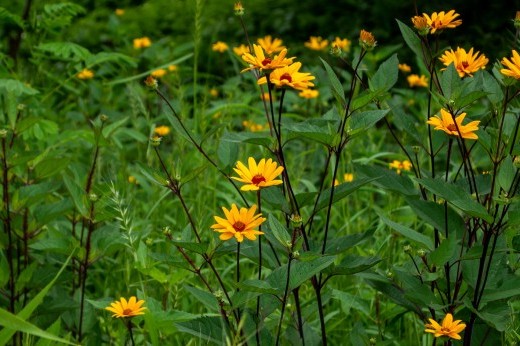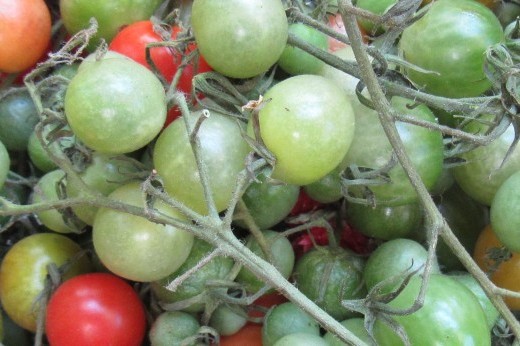As late summer descends on New York City, you may find yourself participating in a strange new East Coast tradition: stomping on the large, exceptionally beautiful polka-dotted insects that now live, accidentally, alongside us.
Spotted lanternflies (Lycorma delicatula) go through four nymphal stages, known as “instars,” before reaching their adult form, molting like soft-shell crabs as their exoskeletons expand. Earlier this summer, you may have seen masses of small black-and-white, beetle-like nymphs, followed by larger red, white, and black nymphs, which are now becoming inch-long winged adults.
They can be spotted flitting around community gardens, drinking sap from trees with their newly mature piercing-sucking mouthparts, or flattened by industrious passersby on a city sidewalk.

“It is definitely a hot topic,” says Shauna Moore, director of horticulture at Brooklyn Botanic Garden. “I’m getting lots and lots of emails and messages from people who want to know what to do, and photos from worried visitors.”
We spoke with Julie Urban, an evolutionary biologist at Penn State University, to get a better sense of what researchers know now about spotted lanternflies and their impacts, and what Brooklynites should be doing about them.
Urban has studied spotted lanternflies and the lanternfly family (Fulgoridae) for over two decades. Keep stomping, she says—but “don’t freak out.”
She helped us answer some frequently asked questions below.
Why do I keep hearing about this bug?
Spotted lanternflies are considered an invasive species and an agricultural pest. They won’t hurt you, but they will feed on a wide range of crops and other plants, and they pose a serious threat to grapevines and vineyards. They’re also seen as a nuisance, startling joggers and outdoor yoga practitioners and excreting honeydew on cars and deck furniture.


“Species in the lanternfly family are really unusual among sap-feeding insects, because they’ll lay their eggs on pretty much anything,” says Urban. Spotted lanternflies are also not picky eaters, and they’re pretty mobile, even as nymphs. Together, these factors make them a risky bug to import—they’re “kind of a perfect storm of an insect.”
Early reports from South Korea, where spotted lanternflies are also considered invasive, suggested a potential for serious damage. Stateside, they were first discovered in Pennsylvania in 2014, and were found in New York in 2020. Native to China, Japan, and Vietnam, they likely arrived as egg masses on a pallet of stone that was shipped in by a landscaping company, says Urban.
Since then, these talented hitchhikers have been found in 14 states, and officials have asked residents to “stomp it out” to help contain their spread.
How serious are their impacts?
While there are still unknowns, says Urban, “they’re not as bad as we thought they would be.”
Spotted lanternflies are bad news for vineyards. They can kill grapevines, along with their main host plant, the (also invasive) tree of heaven (Ailanthus altissima), when they feed on those plants in high numbers.
But for most plants and trees, they seem to be more of a stressor, says Urban, based on reports from growers and studies that caged lanternflies at different densities with various host plants. Often, she says, they’ll move on before causing damage.

Combined with other stressors, spotted lanternflies may become a bigger problem, says Urban. (And plants these days certainly don’t lack for—or need more—stressors.) But in Philadelphia, she pointed out, stressed-out street trees have been hit by spotted lanternflies for several years, and “those trees aren’t dying.”
Still, there are plenty of unanswered questions, particularly as they’re inadvertently transported into new regions and ecosystems. “As it shifts its range, the story of its impacts is going to change.”
What about “sooty mold?” Is that what’s killing my peach tree?
When a spotted lanternfly drinks a plant’s sugary sap, the insect excretes sugar water, or honeydew, which is a substrate for a type of fungus known as sooty mold. Sooty mold doesn’t itself hurt plants, but with enough buildup, it can stress or even kill them by blocking light and disrupting photosynthesis.
Sooty mold doesn’t appear to be seriously damaging fruit trees in the U.S., says Urban. In these cases, she explained, the insects don’t seem to stick around long enough to cause a problem.
Where we do see sooty mold damage, she added, is in plants that are growing underneath areas where spotted lanternflies are feeding, like understory plants at woodland edges. “On the edges of forests, it blackens the understory plants, and it kills them—it looks like they were burned,” she says. “What does that mean for mulberry, wild grape, things that are food resources for wildlife? And what does it mean for regeneration of those understory plants?”
More research is needed, she says, to quantify those effects.
Do they have any natural predators here?

Some insects and animals will snack on lanternflies, including praying mantises and certain birds (even chickens). “But not in enough numbers to really put a dent in the population, at least that we know of,” says Urban.
Instead, researchers are studying parasitoid wasps native to China that evolved alongside lanternflies and help keep their native population in check. But more testing is required to demonstrate that importing these wasps won’t harm other insects.
What are BBG gardeners doing?
The Horticulture team has been focusing on disrupting the insects’ life cycle by scraping egg masses off trees and other surfaces and dousing them in rubbing alcohol, as well as eliminating individual nymphs and adults when possible, according to director of horticulture Shauna Moore.
“We are watching these critters closely,” says Moore. But while she’s seen lanternflies do some damage, she has not seen them take down an ornamental plant. Thus far, she says, no plants at Brooklyn Botanic Garden have been lost to spotted lanternflies.
“I think more and more, we’re learning to live with it,” she says. As the science evolves and we learn more, she adds, the Garden’s response may adjust.
What should NYC residents do?
Experts still recommend that people squish or stomp on the bugs when you see them. You can also find and scrape egg masses, which resemble mud, and destroy them. Each mass contains 30–50 eggs.

“If you see it, you should kill it, as much as that breaks my heart,” says Urban. “If you don’t kill it, you’ll carry it, is the idea.” The goal is to slow its spread to new areas, especially those with vineyards, while researchers continue to work on potential solutions.
But Urban’s central message to Brooklyn residents? “Don’t freak out”—or go overboard. Unnerving though it may be to see them clustered on your fig tree, you may want to think twice before reaching for pesticides or elaborate home remedies that can harm other creatures.
“I think there’s potentially more of a problem if people want to spray insecticides preventatively,” Urban says. “That’s going to do more harm than good.”
If you’re concerned about a particularly prized plant that is receiving a high number of lanternfly visitors, try installing a circle trap or a sticky trap that’s been modified to avoid bycatch (meaning animals and insects that aren’t lanternflies), says Urban.
Where can I get more information?
Check out New York State IPM for a map of sightings, management options, reporting tools, life cycle information, and more. PennState Extension’s Spotted Lanternfly Management Guide offers additional details and guidance.



